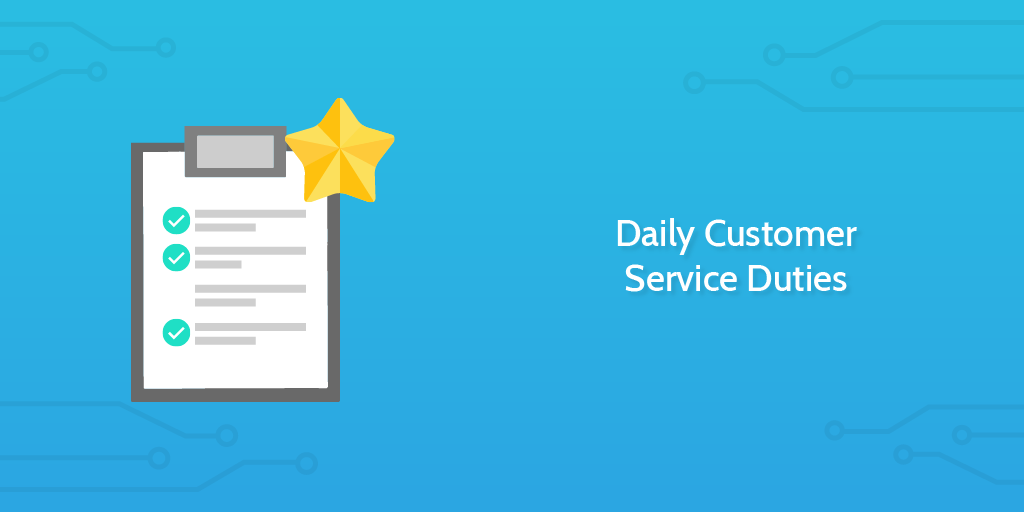
A buggy Netflix account. A defective iPhone. Faulty B2B software.
There’s nothing more frustrating than when products and services encounter issues, or when they simply don’t work at all.
Consumers expect the products and services they buy to perform properly. After all, they’ve handed over their hard-earned money to the vendor in exchange for goods.
Who do consumers turn to for assistance? Customer support.
However, a customer-facing employee can only carry out excellent service if they’re onboarded correctly, fully trained, taught how to interact with customers, and given regular feedback on their performance.
If consumers aren’t impressed with their experience, they can churn immediately and leave negative reviews in their wake. Should the churn rate increase and harmful reviews accumulate, it could be the death knell of an entire business.
At Process Street, we know about – and strongly believe in – effective customer support. In fact, we operate a policy where each new employee must undergo a period of customer support experience, which amounts to a few weeks in total.
That’s why we created these 17 free templates for other teams.
The process templates featured in this free template pack will help strengthen any customer-facing team’s ability to perform successfully. From new employee training checklists to performance reviews, churn reduction checklists to a guide on responding to negative reviews, we’ve got your workflows covered.
What is customer support?
Before deep diving into the templates themselves, let’s take a second to differentiate between customer service, customer success, and customer support.
Let’s start off with customer support.
In layman’s terms, customer support is when customers are assisted by a company representative.
The aim is to have the customer’s questions, problems, and issues answered and resolved accordingly. The majority of issues are raised via email, live chat, support tickets, forum posts, and direct messages – in addition to more traditional methods, such as phone calls.

This is the nucleus of any customer support team member’s role. However, tasks and responsibilities change depending on seniority.
In this sector, there’s a hierarchical system known as “levels”. Generally, these levels range from 1 to 3.
A first-responder to support tickets will usually be level 1 support, or level 2 if the issue requires deeper knowledge to solve. If a customer interacts with level 3 support, they’ll be conversing with expert product and service specialists.
In essence, customer support means helping the customer through their problems, whether they’re micro or macro.
The difference between support, service, and success
Support, service, and success are often used interchangeably as there is such a large overlap. Service and support particularly so, as, in addition to carrying out a majority of the same tasks, both also use similar processes – like for customer interaction and records management.
Due to these shared similarities, the terms are applied to job titles and team names fairly liberally. This can often confuse people regarding their subtle distinctions.
Let’s clear the air.
Customer service
The major difference is that service staff help customers before the customer encounters an issue or pain point. A service member then accompanies the customer until a resolution has been found, helping to increase customer satisfaction, thereby raising customer retention rates.
Service staff also interact with customers via additional venues. For instance, through online review sites and social media. They don’t just focus on replying to tickets coming in from online portals and help desk software.
All in all, it’s a more proactive approach.
Customer success
Customer success is a business approach which centers on the long-term success of customers. It’s a cross-team effort where the likes of marketing, support, service, and design teams come together.
They collaborate on actions to establish relationships with customers and guide them on their product or service journey. This causes retention rates to rise and churn rates to subside, and helps businesses achieve their strategic goals.
Why are processes important to customer support?
No matter if an employee is more rooted in support, service, or success, they must have the customer’s contentment at heart. To provide a high-grade yet well-rounded experience, elements from all three must be applied.
Given the fast-paced nature of customer-facing work, implementing processes is necessary. Processes provide structure. They help get the job done swiftly. And they ensure no missteps occur. Ever.
More than that, document workflows can help new and old employees alike get their job done to a higher standard. The instructions for every task are in front of them, so there’s no reason to get it wrong or not know what to do.
Customer support processes quicklinks
We’ve created these 17 processes to help bolster the performance of your team. If you want more information regarding the checklists, keep on reading. If you’re raring to dive straight in, click the quicklinks below.
- Daily Customer Service Duties
- Customer Service Performance Review
- Employee Performance Review
- Customer Service Training
- Records Management Training
- How to Respond to Negative Reviews
- Customer Journey Map Template
- Reduce Churn Checklist
- Customer Feedback
- Customer Service Interview Process With Questions
- Employee Discipline Checklist
- Performance Management
- Performance Review Template
- Standup Meeting Checklist
- Customer Support Process Checklist
- The Process for Business Process Reengineering
- The Process for Optimizing a Process
Daily customer service duties
Your daily duties are often the most important; that’s why they’re performed each and every working day. To get these pivotal recurring tasks completed to a high quality, you have to stay engaged, productive, and stress-free.
That’s easier said than done.
57% of employees who are stressed at work said stress interferes with being engaged and productive. Additionally, 68% of employees said they suffer from work overload, thereby impacting their ability to get work done.
Considering you’re working in such a fast-paced environment, launch this daily duties checklist to start each day correctly. It will help you plan and track your daily duties in a methodical, time-effective way.
Click here to get the Daily Customer Service Duties checklist
Customer service performance review
Employees wanting to know how they’re doing at work is certainly not going out of fashion. In fact, 60% of millennials actively want to hear from their managers at least once a day.
What does this mean? It means that, as more and more millennials make up the brunt of the modern workforce, the way in which businesses go about internal processes must be altered.
One of the most prominent changes with performance reviews is frequency. Long gone are ye olde days of yearly performance reviews; frequent reviews are becoming the norm. This is particularly beneficial for customer-facing teams. Regular touch points and communication bolsters their ability to provide outstanding experiences.
This checklist will help you review performance easily and effectively, every two weeks. From overseeing onboarding progress to reviewing meeting attendance, increasing team motivation to evaluating key metrics, this performance review has you and your team set.
Click here to get the Customer Service Performance Review checklist
Employee performance review
In addition to customer support and service team reviews, we’ve built an employee performance review template to be launched by managers.
Having a review specifically for singular employees ensures the manager can scrutinize smaller details, data, and information, which might not otherwise come up during a team review. By going through the tasks, managers can garner exactly how their employees are performing on an individual basis.
Like the team performance review, this checklist makes use of conditional logic. Conditional logic is an ingenious ‘if this, then that’ tool, changing a task list based on the answers given. This means, depending on what has or has not occurred, tasks deemed as unnecessary are automatically skipped.
Click here to get the Employee Performance Review checklist
Customer service training
Customer-facing roles, although highly rewarding, can be taxing. The high turnover rate in this sector proves that. While the average overall turnover rate for all industries is 15%, customer service centers have double that figure at 30-45%.
With this in mind, you may be wondering “what’s the best way to prepare new employees?” The answer is simple. Onboard and train them properly from the get-go.
This training template provides an informational foundation from which new customer-facing staff, like a new customer support representative, can learn. Furthermore, this template is easily editable, should there be a need to change, remove, or add any tasks.
Click here to get the Customer Service Training checklist
Records management training
Over 6 million data records are stolen or lost each day. This isn’t a hyperbolic figure. It’s a proven statistic from the Breach Level Index, a database of publically disclosed data breaches.
As a business, you’re required to keep the data and information of your customers safe. If not, there can be massive legal, financial, and reputational repercussions – especially where GDPR and HIPAA is concerned.
This records management training checklist is valuable to new employees and seasoned staff alike. Newer staff members can learn the ropes of record management, while longer-term employees can be refreshed on best practices.
Click here to get the Records Management Training checklist
How to respond to negative reviews
Businesses thrive on online reviews. Think what TripAdvisor has done for the travel sector; UnTappd for breweries; G2 Crowd for B2B software. Customer reviews play a pivotal role in how your service, product, or company-at-large is perceived.
Negative reviews can have a devastating impact. 22% of consumers won’t buy or use a product or service after reading only one negative review.
Responding to negative reviews is, therefore, fundamental. A company response to an unfavorable customer review has been proven to completely turn the tide around: 33% of customers reconsider and post a positive review in the future, while 34% delete their original review entirely. Our How to Respond to Negative Reviews checklist will help you minimize damage and stop customers from churning as a result.
The checklist contains variables, meaning that information put in at an early stage can be pulled through later; a handy tool for crafting an appropriate reply!
Click here to get the How to Respond to Negative Reviews checklist
Customer journey map template
A customer journey map, in layman’s terms, is a process in which companies create customer personas, so they can target their product and service better. Each step of the customer’s journey – from acknowledgment all the way to post-adoption – is carefully considered.
34% of companies are now integrating customer journey maps into their business practice, given how useful journey maps are in creating a pre-emptive list of actions to carry out.
For the map’s creation, the marketing team and customer support team should work together. This is easy with Process Street’s assign feature, which allows different employees to complete their respective tasks, and, in turn, helps to foster swift workflows.
Click here to get the Customer Journey Map Template
Reduce churn checklist
Churn. It’s a word that strikes fear into the hearts of all teams. And it’s not without good reason: on average, U.S. companies lose over $136 billion dollars every year due to customers switching.
The worst part? The switching could’ve been avoided.
This checklist, which has been created specifically for businesses to retain their customers, will help customer-facing and marketing teams to reduce overall churn.
By going through this checklist on a monthly basis, you can track churn rates, compare against previous statistics, and reduce churn going forward.
Don’t let customers run away. Run this checklist instead.
Click here to get the Reduce Churn checklist
Customer feedback

Gaining insight into how customers feel about your product or service is invaluable. With the information, you can amend any issues and improve your business for the better.
This checklist will aid you in your customer feedback search, and provide the complete process for customer feedback data extraction.
Click here to get the Customer Feedback checklist
Customer service interview process with questions
Considering the high turnover rate of customer-facing employees, it’s necessary to keep on top of recruiting. And what better way to ensure you’re doing just that than with a standardized process?
With this checklist, you will begin with the initial review stage and make your way through each step in the hiring process until the right decision has been made.
Here’s to an intelligent way of hiring.
Click here to get the Customer Service Interview Process With Questions
Employee discipline checklist
Disciplinary action doesn’t always have to be negative. Rather, it can be a pivotal form of learning both for the employee and the team they’re working with.
This employee discipline checklist contains the necessary steps for when action needs to happen. Seeing as the type of discipline will differ depending on the situation, this checklist includes a range of disciplinary methods for you to implement, including verbal warnings, written warnings, suspension, and termination.
Click here to get the Employee Discipline Checklist
Performance management
Need a more generalized management review, rather than the customer service and support-focused template we provided earlier? Look no further.
This checklist gives you the steps to manage performance in a quick and efficient manner. As it’s shorter, this could be used as a weekly review.
Click here to get the Performance Management checklist
Performance review template
If the above performance review doesn’t quite meet your needs to review specific employees, this template will.
This template emphasizes individual performance, rather than being a team review. Given that this is a broader and more generalized review template, it can be used for a variety of customer-facing sectors.
Click here to get the Performance Review Template
Standup meeting checklist
No matter if you define your daily 5-15 minute meeting as a daily scrum or a standup meeting, the meeting is an effective method of delivering information in a direct way.
If you’re wanting to solidify your team’s daily scrums or standup meetings – or if you’re seeking to introduce them to your team’s daily practice – this checklist contains everything you need.
Click here to get the Standup Meeting Checklist
Customer support process checklist
Customer service and customer support representatives spend the majority of their time answering tickets. After their initial training on support tickets, they need a process that will guide them through responses for different types of customer tickets.
This is where this checklist comes in. From answering simple questions to tricky technical issues, this checklist will help your team to truly support your customer base.
Click here to get the Customer Support Process Checklist
The process for business process reengineering
Processes are great for productivity, standardizing procedures, and keeping organized. But there will be times when processes need to be altered or stopped entirely.
Considering customer support teams rely on a myriad of processes, this reengineering process will help the team ensure their crucial processes are functioning and still relevant.
Click here to get The Process for Business Process Reengineering
The process for optimizing a process
Processes need to be regularly reviewed and, if need be, reengineered. An additional and highly-recommended step is to consider if processes can be further optimized.
If a process is useful overall but has a specific step or section slowing users down, then it’s not optimal. Luckily, this can be easily rectified, thanks to this checklist!
Click here to get The Process for Optimizing a Process
Other useful resources for customer-facing teams

Not only do we provide actionable templates and checklists for customer support teams, but we also have an array of other useful resources to help you succeed.
Adam Henshall, a content writer at Process Street, has written a thorough, informative guide on formulas to calculate churn rate, ways to reduce churn, and how Process Street can help.
If you’re working in the SaaS space, we have a (free) eBook tailor-made for you.
Check out our definitive guide which explains customer success, customer retention, customer success processes, and how automation can be advantageous.
We adore processes. That’s because we strongly believe that processes make everything easier. Via the link below, you’ll find additional processes for customer service and customer support teams.
Have the 17 customer support processes helped improve your team’s workflows? Are there any other checklists for consumer support services you’d like to see in the future? Let me know in the comment section below. I’d love to hear your thoughts!





















Thom James Carter
Thom is one of Process Street’s content writers. He’s also contributed tech-related writing to The New Statesman, Insider, Atlassian, G2, The Content Marketing Institute, and more. Follow him on Twitter @thomjamescarter.